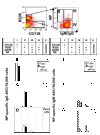The agonists of TLR4 and 9 are sufficient to activate memory B cells to differentiate into plasma cells in vitro but not in vivo
- PMID: 18641311
- PMCID: PMC2679533
- DOI: 10.4049/jimmunol.181.3.1746
The agonists of TLR4 and 9 are sufficient to activate memory B cells to differentiate into plasma cells in vitro but not in vivo
Abstract
Memory B cells can persist for a lifetime and be reactivated to yield high affinity, isotype switched plasma cells. The generation of memory B cells by Ag immunization requires adjuvants that generally contain TLR agonists. However, requirements for memory B cell activation and the role of TLRs in this activation are not well understood. In this study, we analyzed the response of memory B cells from immunized mice to TLR9 and 4 agonists CpG oligodeoxynucleotides (ODN) and LPS. Mouse memory B cells express both TLR9 and 4, and respond to both CpG ODN and LPS in vitro by differentiating into high affinity IgG secreting plasma cells. In contrast, neither CpG ODN nor LPS alone is sufficient to activate memory B cells in vivo. Ag is required for the clonal expansion of Ag-specific memory B cells, the differentiation of memory B cells to high affinity IgG secreting plasma cells, and the recall of high affinity Ab responses. The Ag-specific B cells that have not yet undergone isotype switching showed a relatively higher expression of TLR4 than memory B cells, which was reflected in a heightened response to LPS, but in both cases yielded mostly low affinity IgM secreting plasma cells. Thus, although memory B cells are sensitive to TLR agonists in vitro, TLR agonists alone appear to have little affect on B cell memory in vivo.
Figures





References
-
- McHeyzer-Williams LJ, McHeyzer-Williams MG. Antigen-specific memory B cell development. Annu Rev Immunol. 2005;23:487. - PubMed
-
- Anderson SM, Tomayko MM, Shlomchik MJ. Intrinsic properties of human and murine memory B cells. Immunol Rev. 2006;211:280. - PubMed
-
- Hofer T, Muehlinghaus G, Moser K, Yoshida T, H EM, Hebel K, Hauser A, Hoyer B, E OL, Dorner T, Manz RA, Hiepe F, Radbruch A. Adaptation of humoral memory. Immunol Rev. 2006;211:295. - PubMed
Publication types
MeSH terms
Substances
Grants and funding
LinkOut - more resources
Full Text Sources
Molecular Biology Databases

